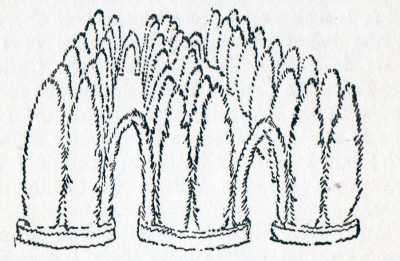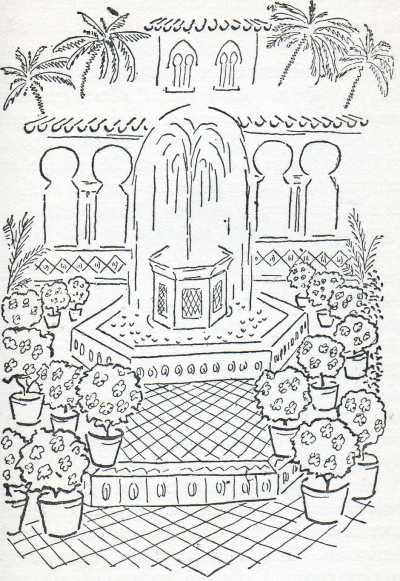Chapter Sixteen - Jardines
Jardines
THE gardens of the Alcazar, in their own particular way, are typical of Spanish gardens as a whole; they contain, it is true, a few odds and ends which are to be seen nowhere else, such as, the baños or the vaulted bath-room of Doña María de Padilla, the mistress of the Christian king Pedro the Cruel. It is said that, in accordance with the etiquette of the time, the caballeros of the court used to drink water from her bath; but I don’t believe this, because I have seen precious few caballeros in Sevilla drink water.
Now I have tried to describe from memory what a Spanish garden looks like; but as there wasn’t room for it on one sheet of paper, I had to make a threefold description:
1. A Spanish garden consists, first and foremost, of cypresses, clipped box-trees, myrtle, privet, laurel, holly, laurocerasus, honeysuckle and suchlike diversely shaped shrubs, pyramids and spheres, from which by a process of clipping, linking and moulding are produced alleys and passages, vaults and arches, green ramparts, palings and borders, hedges, partitions and labyrinths, and, in fact, the whole ingenious geometric architecture of the old, severe school of gardening; and in this sunny land it will be readily understood that this is not really a garden which produces plants, but a garden which produces shade.

2. In the second place the Spanish garden consists, first and foremost, of flagstones, bricks and glazed tiles, majolica flights of steps, faience palings, roundels and seats; further, of majolica tanks, fountains, cisterns, cascades, jets and runnels gurgling with a delicate trickle of water; of faience pavilions, balconies, pergolas and balustrades; wherein the aforesaid majolica is decorated with the neatest of black-and-white chequering, meshing, streaking, patterning or painting in ochre, indigo and Venetian scarlet; and this faience world teems with flower-pots: flower-pots containing camellias, fig-plants, azaleas, abutilons, begonias and coleuses, chrysanthemums and asters; whole avenues and clusters of flower-pots baked to a turn; flower-pots on the ground, on the rims of shallow water-troughs, on terraces and on steps.

3. In the third place, the Spanish garden consists first and foremost, of a most luxuriant jungle, of a tropical brushwood thrusting forth a regular jet of palms, cedars and plane-trees, entwined with bougainvillæa, clematis, aristolochiæ, begonia, as well as large-leaved shoots with flowers resembling the convolvulus, which plant is known here as “campanilla,” also other shoots blossoming like thorn-apple, which, too, is called “campanilla,” and other creeping plants, blossoming like a huge clematis and likewise named “campanilla”; then there are dracaena and date-palms, chamærops, acacias, phœnix-palms, and – how on earth am I to know all their names?
If you only knew the kind of leaves they have! Glossy and stringy, tufted like ostrich feathers, unsheathed like broad-swords, fluttering like banners; and you can take my word for it, that if Eve clad herself in one of these leaves, it was not to cover her shame, but for the sake of display and luxury. In this dense paradisiacal forest there is no room for the tender bud or the blade of grass; it may be that they cultivate grass here only in flower-pots.

I have described this trio for you in three separate sketches; but in reality the whole thing grows in one single spot, which of course, baffles description. The Spanish garden represents, at the same time, a clipped system of gardening, crammed with miniature faience fountains, terraces, roundels and steps, littered with flower-pots, draped with palm-jungles and creepers; and the whole lot sometimes occupies no more than a bare handful of ground studded with fountains and runnels; never have I seen gardens so amazingly concentrated and intensified as in Spain.
An English park is a cultivated landscape; a Spanish garden is an artificial paradise. A French park is a monumental edifice; a Spanish garden is an intimate dream. In those nooks soft with shade, gurgling waters, cool majolica, dazing fragrance and tropical leafage is the gentle tread of another, a more pleasure-loving race; here too, the Moors have left their traces.
